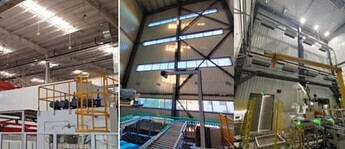Preface
Target readers: Solution engineers, layout planning engineers, mechanical design engineers, mechanism design engineers, commissioning engineers
Introduction: This article focuses on the installation scenario of open-top turnover box depalletizing projects. It provides detailed requirements for the installation site, lighting conditions, power supply, and gas supply for a single depalletizing station. This information is instructive for the design and on-site installation of open-top turnover box depalletizing solutions.
1. Ground and Floor
When the Mech-Mind vision system is applied in the logistics industry, it is usually used in conjunction with robots, conveyor lines, and warehouses. Especially, robots have higher requirements for the ground or floor, as specified in the table below.
| Static Load | ≥3 T/sq.m |
|---|---|
| Material | Concrete |
| Concrete grade | Not less than C30 grade |
| Pouring depth | Not less than 150 mm, recommended above 200 mm |
2. Installation Space
In actual logistics projects, it’s necessary to consider the requirements of camera field of view, robot gripping space, and other interference factors. Here are some points to note:
-
The clear height of the installation position for the depalletizing station should be no less than 4 meters. This is primarily due to the following considerations: it should facilitate robot installation and construction, ensure the camera’s field of view, and provide ample space for robot movement.
-
Within the robot’s range of motion, avoid the presence of columns or other obstructions to ensure the robot can move freely without being restricted by obstacles.
-
When installing the camera, there should be no obstructions below the camera that interfere with its field of view. This ensures the camera can capture the target objects properly and provide accurate vision information.
-
Pay attention to interferences from main beams, secondary beams, firefighting water pipes, artificial light sources, or air ducts during camera installation. When planning the camera’s position, it’s essential to avoid these interferences to ensure the camera can be installed as required.
In summary, when installing Mech-Mind vision system in logistics projects, it’s crucial to fully consider these factors. Close collaboration with the design team, contractors, and relevant personnel is necessary to ensure the system is properly positioned.
3. On-Site Lighting Conditions
Lighting conditions significantly impact the imaging quality of 3D cameras. Here are some influencing factors:
Factor 1: Excessive Lighting
This factor can cause overexposed images, preventing the camera from providing complete 2D images and 3D point clouds. Common sources of strong light in projects include skylights, sidelights, and artificial strong lights as shown in the pictures below:

Solution: To obtain good data, it is recommended that the surface light intensity of the turnover box does not exceed 800 lux. If the lighting is too strong, you can set up a shading canopy.
For details, please refer to A comprehensive guide to shading solutions.
Factor 2: Uneven Lighting
This factor affects deep learning.
Solution: Generally, using a shading canopy or adding supplementary lights can ensure uniform lighting on the surface of the turnover box. Common supplementary lights include white ordinary LED strips or surface light sources with adjustable color temperature of 6000k and adjustable light intensity.
For details, please refer to a comprehensive guide to shading solutions.
4. Whole Site Power Supply (Reference)
| Grid | TN-S network (three-phase five-wire system, 3-ph, N, PE) |
|---|---|
| Three-phase voltage | Standard: 380 V AC |
| Frequency | 50 Hz, +/- 1Hz |
| Grounding | Adopting a unified grounding method (Resistance value should not exceed 4 Ω) |
| Power consumption | Single workstation should not be less than 14k VA |
5. Customer-Supplied Compressed Gas
- Dry, clean, and oil-free: To ensure the normal operation of the system and the lifespan of pneumatic components, compressed gas should undergo drying, cleaning, and oil removal treatment. This can be achieved by using appropriate filters and dryers. Additionally, the compressed gas should not contain organic solvents, salts, corrosive gases, or similar components.
- Gas pressure: The operating pressure of the compressed gas should be between 0.6 MPa and 0.8 MPa, and pressure fluctuations should be controlled within a range of less than 10%. This can be achieved by using suitable pressure regulators and stabilizing devices.
- Temperature and humidity: The temperature of the compressed gas should be between -5 °C and 70 °C. In situations below 5 °C, it is necessary to remove moisture to prevent freezing or other issues. Furthermore, the relative humidity should be kept below 80% to avoid adverse effects on the system due to excessive humidity.
- Gas flow rate: Depending on the selected pneumatic components and actual requirements, ensure an adequate flow of compressed gas. This can be achieved by designing the system rationally and selecting compressors of appropriate specifications.
In summary, for the use of compressed gas, dryness, cleanliness, and oil-free conditions are essential requirements. Additionally, it is important to ensure pressure stability, temperature control, and humidity control. Also, make sure to provide an ample gas flow rate to meet the system’s requirements.
